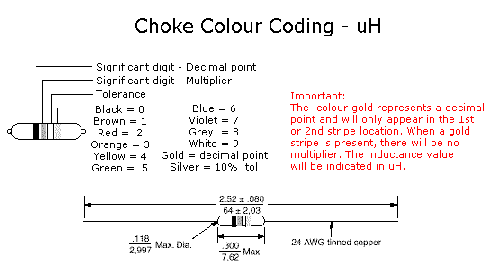|
|
|
MODULE V - FUNDAMENTALS OF ELECTRONICS
What are chokes? Chokes are fixed inductors primarily intended to "choke" off alternating currents, including rf from DC supply lines. The "rf choke" is designed to have a high impedance over a large range of frequencies. This is quite different to fixed inductors which are meant to be used for tuned circuits. You could in some very casual applications substitute chokes for fixed inductors but as a general rule and of course there are exceptions to this rule, you shouldn't. One exception might be applications involving either non-critical high pass filters or low pass filters. On the other hand don't consider using a choke in a fixed inductor application such as a quality narrow band filter or in the frequency determining stages of an LC oscillator. The principal objection relates to the "Q" of the choke. Secondary objections would relate to the thermal stability of the choke. Typical moulded chokes which can be purchased fairly cheaply aren't exactly designed to be monuments to either high "Q", thermal stability or high tolerances. |
|
Further objections relate to self resonant frequency (SRF). A choke, as with any inductor, also exhibits some degree of self-capacitance or "distributed capacitance". This capacitance in conjunction with the design inductance are resonant at some particular frequency. Choke resonant frequencies At low frequencies this capacitance has virtually no effect and the choke could be depicted as in "A" below in Figure 1. The resistance is the inherent resistance in the choke both at ac and dc. When the operating frequency is raised the "distributed capacitance" starts to become significant at a point where L and C form a parallel resonant circuit as in "B".

Figure 1. - choke resonant frequencies Increasing the operating frequency further again we find the choke's reactance is dominated by the capacitance to a point where it is now a series resonant circuit "C". At this point the chokes performance becomes seriously impaired. Moulded chokes Typical of the economical chokes which tend to look like resistors and are color coded in a similar fashion in the following figure 2 which is a choke color code chart. Choke Color Code Chart

Figure 2. - choke color code chart Generally speaking these chokes are designed for miniaturisation and whatever type you intend to use always double check to ensure it can handle the expected current. Most important!, you don't want it functioning as a "flash" fuse, pun intended. Simple low value chokes can often be fashioned cheaply by winding turns of wire capable of carrying sufficient current on to a suitably large body resistor. A plastic type former could also be used by using a section cut off say a knitting needle. At higher frequencies consider a small air wound choke. Cheap chokes too. Home made chokes are often easily wound on high permeability ferrite toroids, ferrite beads or even the binocular type cores used for baluns. Just remember to use a wire gauge which will comfortably handle the expected current through your chokes. Also remember the higher the permeability of the core the less turns required and the less "distributed capacitance" appearing in your chokes. Should your budget allow consider building an LC meter kit to be able to measure either the inductance of your chokes, inductors or even check the capacitance of capacitors. |
|
|
|
Copyright �2000-2002 [email protected] -- All Rights Reserved -- Designed by WebCreations


